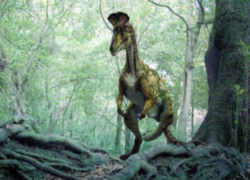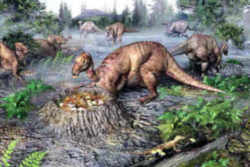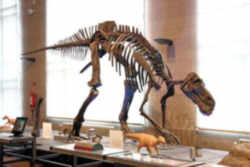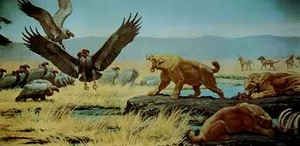
Montana Symbols
Montana State Fossil
Duck-billed Dinosaur

(Maiasaura peeblesorum)
Adopted on February 22, 1985.
Because of its scientific importance, a group of middle school students led by Helen Peterson, a sixth-grade teacher from Livingston Middle Schooland and a rockhounds headed by Ben Veach, former president of the Montana State Council of Rocks and Minerals from Livingston were leading the drive to crown the Duck-billed Dinosaur, Maiasaura peeblesorum, as Montana's state fossil. The legislature passed Bill 130 with a unanimous "yea," and it was signed into law by Governor Ted Schwinden on February 22, 1985. Maiasaura (from the Greek meaning "caring mother lizard") is a large duck-billed dinosaur genus that lived in the area currently covered by the state of Montana in the Upper Cretaceous Period (Campanian), about 74 million years ago.
Montana State Fossil: Duck-billed Dinosaur

Maiasaura was large, attaining an adult length of about 9 metres (30 ft) and had the typical hadrosaurid flat beak and a thick nose. It had a small, spiky crest in front of its eyes. The crest may have been used in headbutting contests between males during the breeding season.
This dinosaur was herbivorous. It walked both on two (bipedal) or four (quadrupedal) legs and appeared to have no defense against predators, except, perhaps, its heavy muscular tail and its herd behaviour. These herds were extremely large and could have comprised as many as 10,000 individuals. Maiasaura lived in an inland habitat.
Scientists digging in Choteau, Montana, found "Egg Mountain." The mountain, and the area surrounding it, was filled with fossilized eggs, babies, and adult dinosaurs from 80 million years ago. It was the first proof that some dinosaurs took care of their babies the way birds do now. That's how the Maiasaur got its name, which means "good mother lizard."
 Their round
nests were six or seven feet wide and could hold 25 eggs. The hatched babies weighed about as much as a phonebook and were about one foot long. Adult
Maiasaurs weighed almost 6,000 pounds (or about the same as a car with six people in it) and were almost 30 feet long (about as long as the inside
of most movie theaters). This plant-eater had a toothless beak, cheek pouches, and many self-sharpening cheek teeth. Hard enamel was found on both
the outer surface of the upper teeth and the inner surface of the lower teeth. Maiasaura's hands each had four fingers, and its feet had hoof-like
claws. Maiasaura walked on four legs, and was a moderately fast dinosaur. Its front legs were much shorter than the rear legs. When Maiasaura ran,
it probably only used the back legs, with the tail providing balance. Running was this dinosaur's only means of escaping carnivores like Albertosaurus
and Troodon.
Their round
nests were six or seven feet wide and could hold 25 eggs. The hatched babies weighed about as much as a phonebook and were about one foot long. Adult
Maiasaurs weighed almost 6,000 pounds (or about the same as a car with six people in it) and were almost 30 feet long (about as long as the inside
of most movie theaters). This plant-eater had a toothless beak, cheek pouches, and many self-sharpening cheek teeth. Hard enamel was found on both
the outer surface of the upper teeth and the inner surface of the lower teeth. Maiasaura's hands each had four fingers, and its feet had hoof-like
claws. Maiasaura walked on four legs, and was a moderately fast dinosaur. Its front legs were much shorter than the rear legs. When Maiasaura ran,
it probably only used the back legs, with the tail providing balance. Running was this dinosaur's only means of escaping carnivores like Albertosaurus
and Troodon.
This dinosaur was first discovered in Montana. Since then, thousands of Maiasaura fossils (adults, hatchlings, juveniles, nests, eggs and embryos)
have been found in western Canada and the United States. Marion Brandvold and her son David Trexler found one huge bone bed in Montana dubbed Egg Mountain.
Jack R. Horner & Robert Makela named Maiasaura in 1979.
Maiasaura lived during the late Cretaceous period. It was among the last of the dinosaur species to evolve before the Cretaceous-Tertiary extinction
65 million years ago. Other dinosaurs of this time were Velociraptor, Albertosaurus and Troodon (carnivores that probably preyed upon Maiasauras),
Tyrannosaurus rex (a larger version of Albertosaurus), Ankylosaurus (an armored herbivore), Parasaurolophus, Corythosaurus (a crested dinosaur), and
Dryptosaurus (a meat-eating dinosaur).
2013 Montana Code
The law designating the duck-billed dinosaur as the official Montana state fossil is found in the Montana Code, Title 1, Chapter 1, Part 5, Section 1-1-509.
Title 1. GENERAL LAWS AND DEFINITIONS
CHAPTER 1. GENERAL PROVISIONS
Part 5. State Symbols - Official Designations
1-1-509. State fossil.
Universal Citation: MT Code § 1-1-509 (2013)
1-1-509. State fossil. The duck-billed dinosaur Maiasaura peeblesorum is the official Montana state fossil.
History: En. Sec. 1, Ch. 37, L. 1985.
Taxonomic Hierarchy: Duck-billed Dinosaur
Kingdom: Animalia
Phylum: Chordata
Clade: Dinosauria
Order: Ornithischia
Clade: Ornithopoda
Family: Hadrosauridae
Subfamily: Saurolophinae
Tribe: Brachylophosaurini
Genus: Maiasaura
Species: Maiasaura peeblesorum Horner & Makela, 1979

Some states that lack a "state fossil" have nevertheless singled out a fossil for formal designation such as a state dinosaur, rock, gem or stone.






